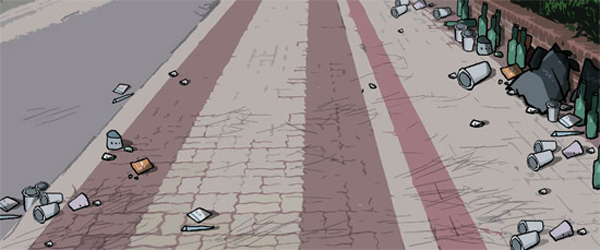Cultural festivals as they should be

Teshima Art Museum in the small island of Teshima in Kagawa Prefecture, southwestern Japan, hosts a single piece of artwork titled “Matrix.” The small island with a population of 1,000 was branded a “junk island” after an industrial waste scandal in 1990. An environmentally-friendly policy and the arts revived the island. The museum was created by artist Rei Naito, 52, and architect Ryue Nishizawa, 47. Since it opened in 2010, it has been attracting visitors from Japan and other countries.
Last weekend, I visited the Setouchi International Art Festival, which was held on 12 islands of the Seto Inland Sea and Takamatsu and Uno ports. Due to my short itinerary, I only visited two islands, Teshima and Ogijima. I had lunch at Shima Kitchen, a restaurant in Teshima that is an artwork in itself, and viewed Tobias Rehberger’s “What You Love Can Make You Cry” and Susumu Kinoshita’s “101-Year-Old’s Silence.” Ogijima is a tiny island with a population of 160, and the three hours I had spent was not enough to appreciate 23 artworks. “Onba Factory” used strollers as art, and “Corridor of Time” expressed the past and present with umbrellas. The installation artworks used the abandoned houses and actual living spaces on the remote island, thanks to the cooperation of the local residents.
Koreans also host events similar to those on the Japanese islands. Recently, the Ihwa-dong Village Museum exhibition opened, and Dongpirang Mural Village in Tongyeong is a permanent outdoor museum. Byeol Byeol Art Village in Yeongcheon, North Gyeongsang, is also famous. Yet, there are still not many community-driven art projects, and visitors often display bad manners. When an event becomes popular, shallow commercialism dominates recklessly. A cafe opens up in the Hanok Village in Jeonju every day, and among the four cities that have earned the “Slow City” designation, Jangheung has already been excluded and recertification is postponed for Sinan.
The villages hosting the Setouchi festival are strictly controlling vendors and restaurants operating without permits. Visitors greeted each other and lined up to appreciate art.
When I returned home on Sunday night, the Seoul International Fireworks Festival was on television. More than 30 people were injured in the crowd, and the festival left tons of waste. Is this how a cultural festival should go? October is supposed to be a month of culture.
*The author is an editorial writer of the JoongAng Ilbo.
By NOH JAE-HYUN
원반형 우주선이 숲 속에 살짝 내려앉은 듯하다. 타원형 내부에 들어가면 제법 넓다. 바닥의 조그만 구멍들에서 물이 천천히 솟아 물방울이 되고, 물방울들이 합쳐져 낮은 데로 각기 다른 모양새로 흘러간다. 신발 벗어야 하고, 떠들면 안 되고, 물방울을 만지거나 밟아도 안 된다. 컨셉트는 존재 자체의 축복과 살아 있는 모든 것에 대한 감사. 조심조심 걸으며 물방울의 움직임에 온 신경을 집중하게 된다. 40분가량 있다 나오는데 왠지 성당이나 절집을 다녀온 느낌이다. 일본 서남부 가가와현의 작은 섬 데시마(豊島)에 있는 데시마 미술관은 ‘모형(母型)’이라는 이 작품이 곧 미술관의 전부다. 인구 1000명의 데시마는 1990년 터진 산업폐기물 투기 사건 탓에 ‘쓰레기 섬’으로 낙인찍혔다. 섬을 되살린 것은 철저한 환경친화 정책과 예술이었다. 미술관은 여성 아티스트 나이토 레이(52)와 건축가 니시자와 류에(47)가 만들었다. 2010년 개관 이래 국내외 관람객이 연중 끊이지 않는다. 지난 주말 데시마 등 세토내해(瀨戶內海) 12개 섬과 다카마쓰·우노항에서 동시에 열린 세토우치 국제예술제를 맛보고 왔다. 짧은 일정이라 섬은 데시마·오기지마 두 곳만 다녀왔다. 데시마에선 그 자체가 작품인 식당 ‘시마 키친’에서 점심 먹고 ‘당신이 사랑하는 것은 당신을 울리기도 한다’(토비아스 레베르거), ‘101세의 침묵’(기노시타 스스무) 등을 감상했다. 오기지마는 인구 160명의 꼬마 섬인데도 골목길을 오르내리며 23개의 작품을 둘러보자니 3시간 일정이 빠듯했다. 노인용 보행기(실버카)를 예술로 승화시키고(온바 팩토리), 우산살로 과거와 현재를 표현한 작품(‘시간의 복도’)이 눈길을 끌었다. 대부분 설치미술인 작품들은 벽지 섬마을의 빈집과 생활공간을 그대로 활용했다. 주민들의 호응 덕분이다. 우리도 뒤처지지 않는다. 얼마 전 개막한 ‘이화동 마을박물관’전(展)이 그렇고, 통영엔 동피랑 벽화마을이 있다. 경북 영천의 ‘별별 미술마을’도 유명하다. 아쉬운 건 마을 프로젝트가 아직 적다는 점과 관람객들의 매너 부족이다. 좀 유명하다 싶으면 무분별하게 파고드는 천박한 상업성도 문제다. 전주 한옥마을은 자고 나면 커피숍 개업이고, 한국 최초의 슬로시티 4곳 중 한 곳이 벌써 퇴출(장흥)되고 한 곳은 재인증이 보류(신안)된 것도 그 때문 아닌가. 세토우치 예술제가 열리는 마을들은 무허가 노점·식당을 철저히 규제하고 있었다. 관람객들은 서로 인사하고 조용히 줄 서서 감상하는 매너로 보답했다. 일요일 밤 귀국해 TV를 켜니 여의도 세계불꽃축제 뉴스가 나왔다. 밀리고 밟혀 30명 넘게 다친 데다 먹다 버린 음식, 쓰레기 천지였다고 한다. 이게 문화축제일까. 10월은 문화의 달이라는데. 노재현 논설위원·문화전문기자










with the Korea JoongAng Daily
To write comments, please log in to one of the accounts.
Standards Board Policy (0/250자)